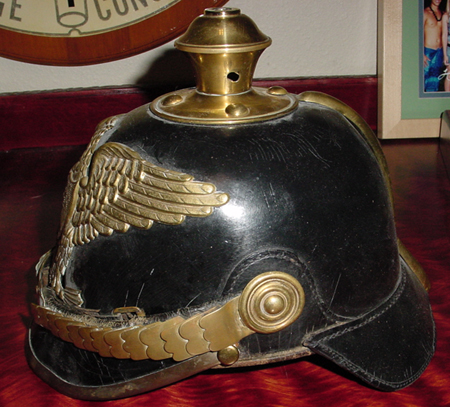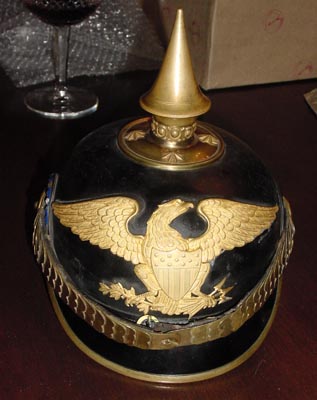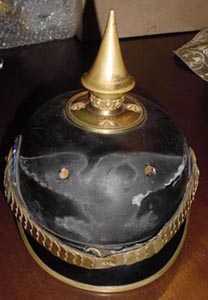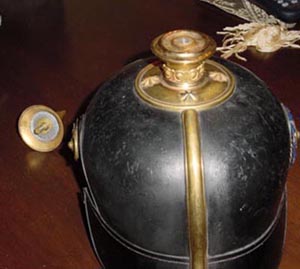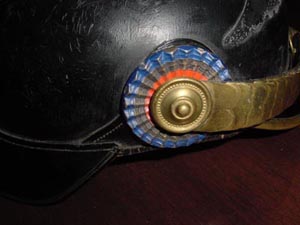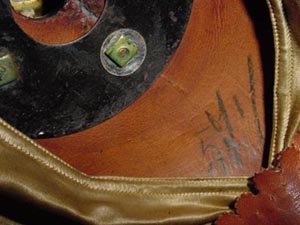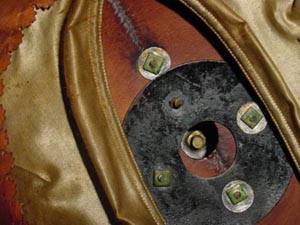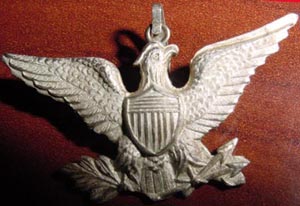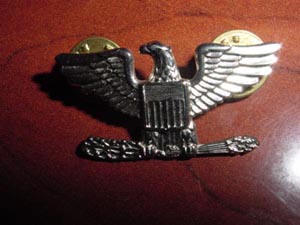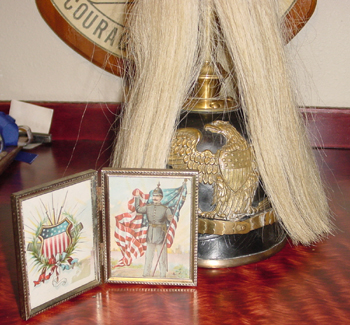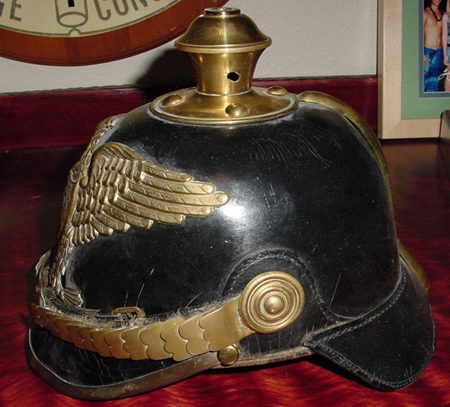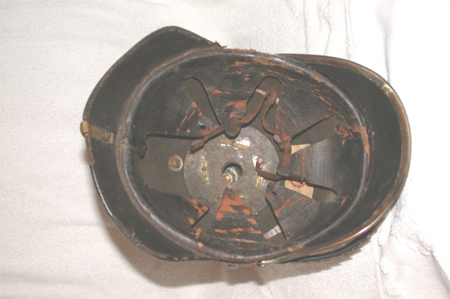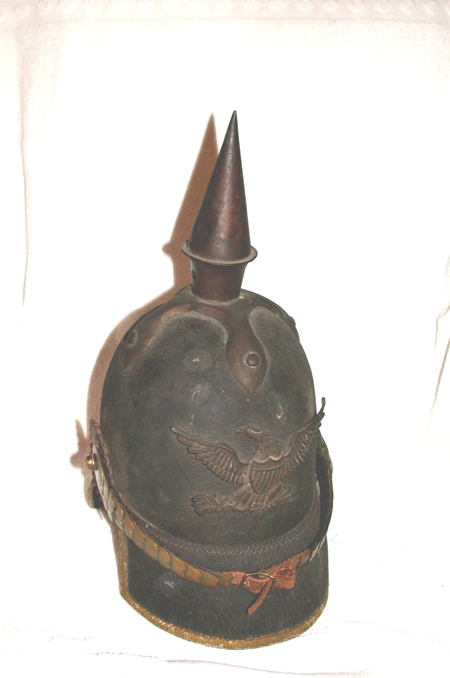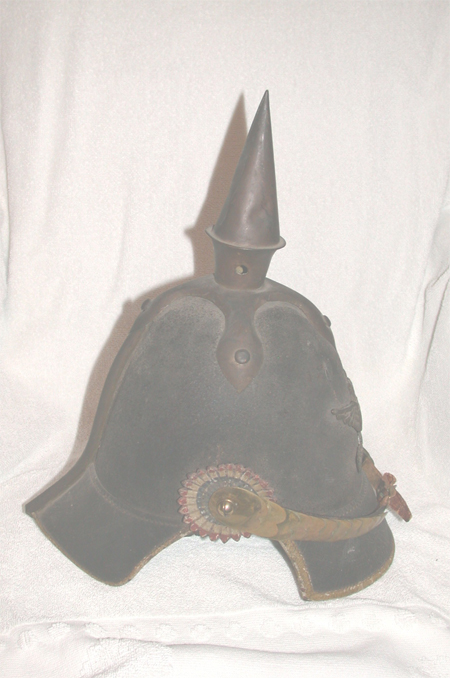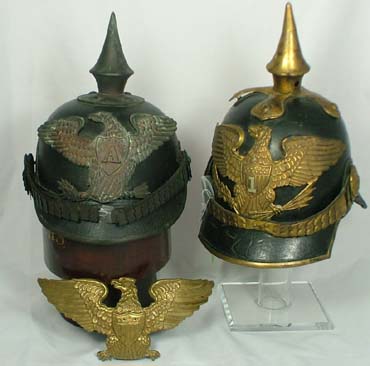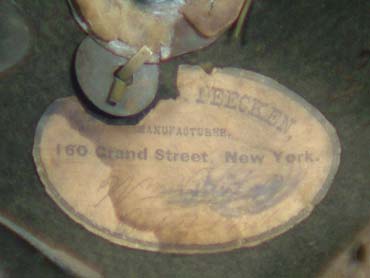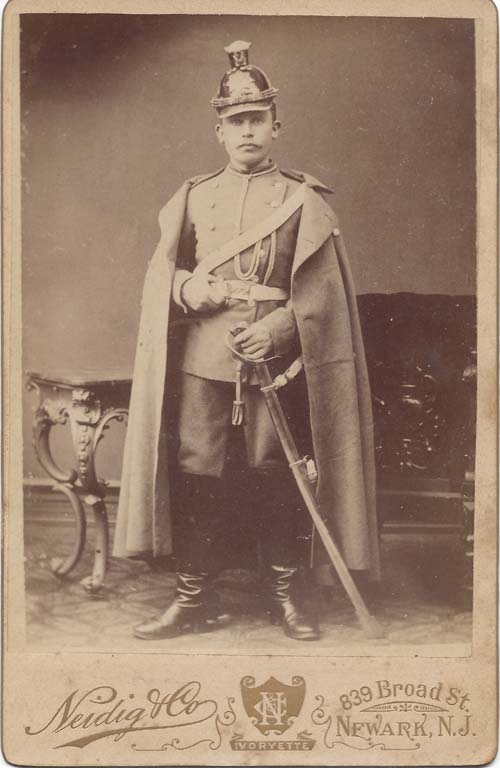The American Pickelhaube
Joseph P. Robinson.
26 May 2005.
In late 2004, a pickelhaube sold in a small auction house in New York. This was an incredibly unique pickelhaube. Competition for the piece was fierce, and the final price was much higher than almost anyone expected. We are all familiar with American pattern spiked helmets. This is not one of them. It was a German style pickelhaube with an American front plate. It is original, not modern, not faked, in pristine condition, probably never worn, and I have no idea what it was for. It could have been a prototype. It certainly wasn’t worn much if at all. But somebody went through a great deal of expense to create this. The way wappen were made required the creation of a die that stamped the wappen from two directions. This was by no means inexpensive and was designed to literally stamp out thousands of helmet plates. The original version of this article brought two more American pickelhaube to the surface. Lately after this was published in Military Trader, The de Quesada collection provided more expertise and models of these militia helmets. First let’s look at the original officers helmet.
This helmet has all the characteristics of an M91 type private purchase German pickelhaube for an officer. The spike, only 9 cm high has the two rings common with officer ones. It has an officer style spike base with two ventilation holes. It has a round base held in place by four star studs. There are chin scales reinforced with leather, split brad rosettes, thin, private purchase visor trim, officers type rear spine, and very good liner and leather. The helmet plate is obviously fire gilded.
Also known as a ghost, this is the impression left by the helmet plate on the body of the helmet. Especially around the head, this impression is quite deep. This is what collectors call a perfect match between the plate and a helmet. This was the original plate for this body.
You can see here the rear spine, and that the spiked unscrews. The threads on the spike are very coarse.
There is only one cockade on the right hand side of the helmet. It is non-serrated and 55 mm wide. This is very similar of course to a German cockade but a non-serrated type, would almost point towards it being non-Prussian in heritage. It would be nice to imagine that this was red white and blue. The reality of it is that it’s more like red black and blue. Even with Saxon gray, which often substitutes for white, this is not gray. It is black. Same kind of chin scales as a German helmet. Same kind of officer rosette with the same measurements.
Here you see the start of a liner on the inside that has a German hat size written in pencil. The liner top is made out of a heavy-duty silk. The sweat band is a very high quality, but unmarked leather.
The visor bottoms are covered in high-quality colorings. What is really amazing is that the leather of the visors has absolutely zero crazing or heat bubbles or any marks of any kind. They are almost mint.
It appears as though the Spike base plate underneath has been removed at some point. One washer is missing and one post is missing both the washer and nut. You can see that the plate is not directly centered below the spike hole. The off-center nature of this appears to be a manufacturing issue and has no real impact at all.
The back of the wappen has two screw posts with old solder. The fire gilding is evident on the back.
Now we start to get to theories. Look at the front of this wappen. An American eagle, head turned one direction, oak leaves in one hand,arrows in another. Head pointed the direction of the arrows. This is an amazingly striking resemblance with the rank insignia of an American Colonel up through the First World War. American colonels wore a very similar spread wing eagle as their rank insignia.
This is a picture all of an American colonel’s insignia from his collar used in the early 1900’s.
You’ll notice the spread wing eagle with the head turned and one hand holding olive leaves and the other hand holding arrows. If the head is turned the direction of the arrows the nation is at war. If the head is turned the direction of the olive leaves the nation is at peace. This is a war eagle. This head turning style went out after the First World War. Today’s eagle is not nearly as detailed and much more politically correct, always looking at the olive leaves.
If you take a look at the helmet plate you will see that it is a war eagle. This brings us to the second helmet. It is an enlisted helmet with a parade plume. It came with a couple of pictures, including one of an American soldier wearing a pickelhaube. These are more like postcard cartoons, not photographs.
This is an enlisted version of the helmet. There are several key differences when compared to the officers helmet. The officers helmet appears to be completely German made with all German parts. Everything that you can consider is German in nature. It is an identical replica of a German officers helmet with an American wappen. This helmet has an issue liner, a thick visor trim, dome studs, no pearl ring, and enlisted rear back spine. However, the fittings on the helmet are not entirely “made in Germany.” In addition this eagle looks at the olive branches and is a peace eagle. The chin scales seemed to be similar to German chin scales, but the rosettes are split brad and are totally different. The liner is similar to a German liner, but is slightly different. The spike base is totally different. The leather helmet itself appears to be in 1871 type model. There are no cockades. Look specifically at the vent hole in the spike base. It is very rough and punched out.
This picture shows the rear spine, the trichter, and the rear visor, which is quite elongated similar to an 1871 pattern helmet.
Information provided from the de Quesada collection adds that there were many of these type helmets produced in low run quantities. This style is representative of helmets made by a NY firm named Deeken. These are somewhat more flimsy in the metal areas than German made helmets.
The last helmet is actually similar to an earlier German helmet M42 model. This one has a cockade that is made of leather, and is red white and blue. There is no liner and this thing has never been cleaned. The cruciform spike base is smaller than its German counterpart, and the spike itself seems rather primitive. There is a uniquely American wappen that has had a patent on it. And again is an eagle of peace. This is an excerpt from an email by de Quesada:
“The early eagle on the M1842 helmet is actually a Model 1832 Shako Plate. I have a few examples of this plate including dug versions from Second Seminole War era sites. It is possible this piece could date to the Civil War and Reconstruction eras. I have this style helmet illustrated in Civil War and Post Civil War era military suppliers catalogs.”
So here goes more theories. Research continues here. Militia units but photo proof?
From Clayton Hunt: Charleston, SC had 3 militia companies before the Civil War that wore Pickelhaubes. The Palmetto Riflemen which used the 1845 Swedish Style with silver trim, Black horsehair and Silver Skull on front. The German Artillery from sketches used the 1845 style helmet as well with brass trim, brass spike but the front appears to be a sun ray plate with crossed cannons on front. Which leaves the German Riflemen founded in 1841 who wore the Pickelhaube as well. The image from their woodcut shows an officer with white plumage on top of his helmet. I am of the opinion that you have a helmet from an enlisted man of the German Riflemen of Charleston since only officers wore plumes. All of the German units of Charleston including the German Fusiliers and German Hussars used US Eagles for plates and belt accoutrements instead of South Carolina plates from my research. The German Riflemen wore the Hanoverian dark green rifleman frocks and black pants as well. Maybe this helps and hope it does or at least adds to the discussion. I am from Greenville, South Carolina and have focused my research on units from here between 1830 and 1861.

